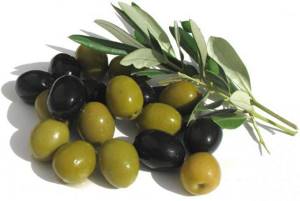Olives contain from 130 to 200 kcal, and they also reduce sugar levels and improve digestion. Find out which olives are the lowest in calories, get a recipe for making marinated and stuffed olives.
Author: Kristina Lobanovskaya, doctor, practicing nutritionist Article updated: 11/09/2020
Ask a Question
Olives are the fruits of the subtropical tree Olea europaea. The height of the olive tree reaches 10 meters; in the spring it is decorated with many small snow-white, very fragrant flowers, which then form bright green drupes measuring from 1 to 4 centimeters. They consist of an oval stone and a fleshy pericarp, and therefore are often classified as berries. As olives ripen, they turn grassy, then purple, reddish brown or black. Fully ripened olives are called olives; both green and ripe ones are used for food. Up to 50 kg of fruits are collected from one tree.
Olea europaea is a long-liver, its average lifespan is 500 years. Trees up to 300 years old are considered productive. They say that the olive trees growing on the Mount of Olives in Jerusalem are more than 2 thousand years old. Greece is still considered their homeland. Currently, large plantations of olive trees are located in Spain, Italy, and they are also grown in the Caucasus, Crimea, Iran, India, Pakistan, Peru and Mexico.
World-famous olive oil is obtained from the fruits of the Olea europaea tree; they are also valued for their excellent taste and healing properties. Including olives in the diet helps prevent:
- anemia;
- hypertension;
- thrombophlebitis;
- vascular diseases;
- diabetes mellitus;
- diseases of the digestive system;
- cholelithiasis and kidney stones;
- bone diseases.
The energy value of olives, depending on the variety and method of preparation, ranges from 130 to 200 kcal/100 g.
How are they good for the body?
To find out why olives are useful, you should take a closer look at their composition, which is a real storehouse of useful substances. It is not for nothing that this product is recommended as a preventative to absolutely all people.
Compound
The chemical composition of olives includes many useful substances. First of all, the fat content is striking - 23.9%. 100 grams of fresh olives contain 39.8% of your daily value (DV) for fat.
These fats contain:
- 15.1 g oleic acid;
- 3.6 g linolenic acid.
Other acids are contained in small quantities. Oleic acid is a monounsaturated fatty acid and plays an important role in fat metabolism.
Carbohydrates in olives: 19 g (9% DV). Of this, 4 g is fiber, which is not digested in the intestines, but stimulates its peristalsis and normalizes the intestinal microflora. 4 g of fiber covers the daily requirement for it by 20%.
There is very little protein - 1.6 g or 2.1% DV.
Of the vitamins, olives contain the most vitamin E, which is very important for maintaining reproductive health in both women and men. Its content is 5 mg per 100 g of olives or 33.3% of the DV.
Olives of varying degrees of ripeness
There are also noticeable amounts of vitamin A and its provitamin, carotene (3.7% and 4% DV, respectively). Very little vitamin PP (1% DV), and very little of the rest.
There are many minerals:
- sodium (350 mg, 26.9% DV);
- calcium (70 mg, 7% DV);
- magnesium (25 mg, 6.3%).
There is potassium (95 mg, 3.8% DN) and phosphorus (20 mg, 2.5% DN), iron (0.5 mg, 5% DN).
Of the microelements we note:
- copper (0.2 mg, 10% DN);
- zinc (0.2 mg, 2% DV);
- selenium (0.9 µg, 4.5% DV).
Calorie content 100 grams
Calorie content of 100 grams of olives is 296 kcal (17.6% DV). This value is average. The calorie content of olives changes as the fruit ripens. Knowing how many calories are in olives is necessary for those who are on a diet and want to lose weight, since their energy value is very high.
Canned pitted olives have slightly less calories. Their energy value is 140-175 kilocalories per 100 grams. But for those olives that were marinated with the pit, it is a little larger. After all, naturally ripened fruits are pickled with it, while those canned without it get their dark color artificially. It is difficult to remove seeds from ripe fruits without damaging the integrity of the fruit, which is why they are not removed.
Useful properties for women
Olives and olive oil should be included daily in your diet. The benefits of olives for women's health include normalizing the synthesis of estrogens and gestagen (female sex hormones) and improving the functioning of the reproductive system,
The beneficial properties of olives are determined by the fact that they contain oleic acid, which gets its name from them. This monounsaturated fatty acid belongs to the omega-9 acids. It is not essential, and if there is a lack of it in food, it is synthesized in the body. But natural products are much more useful, since with them a person receives a whole complex of biologically active substances, which enhances the properties of individual components. Olives contain a lot of tocopherol - vitamin E, phytosterols and selenium, which work together with oleic acid.
It has long been noted that residents of Greece, Spain and Italy suffer much less often from heart attacks, diabetes and cancer, especially breast cancer. This is explained by the fact that there are a lot of olives and olive oil in the diet, and it is oleic acid that protects against these terrible ailments.
But the benefits of olives for women are not limited to cancer prevention. A lack of oleic acid manifests itself in dry hair, skin and mucous membranes. Olives help maintain youth for many years, as they make the skin elastic, hair thick, and nails beautiful. Olive oil is included in many cosmetic products.
Usefulness for men
Canned olives are also good for men, who also need vitamin E, zinc, oleic acid and selenium. Men of working age are much more likely to suffer from diseases of the cardiovascular system: atherosclerosis, coronary artery disease, myocardial infarction and stroke.
Olives have minor anti-ischemic, vasodilating and antiplatelet properties. These effects, when used systematically, have been proven to reduce the risks of the diseases listed above.
Bones
People who eat olives are less likely to experience bone loss and osteoporosis. The latter is characterized by a decrease in bone mass and bone quality, which can increase the risk of fractures. Olives contain hydroxytyrosol, as well as oleuropein, which is associated with calcium production in the body. Adding olive fruits to your diet will protect you from a hereditary predisposition to bone disease.
The risk of osteoporosis in Mediterranean countries is significantly lower than in other European countries, which has led scientists to suggest that olives offer protection against this disease.
Is there any harm from using it?
The benefits are clear, but can olives cause harm to the body? The daily norm is no more than 100 g of green and black olives with pits and 50 g of black ones without pits.
If you consume only olive oil, the body will be harmed, since omega-6 unsaturated fatty acids will not be supplied enough, and omega-3 will not be supplied at all. Therefore, the usefulness of olives and olive oil will increase if you supplement them with nuts and seafood, as well as fatty sea fish. Can you fry in olive oil?
Circulation
Olives are rich in iron and copper. These are the two main components needed to create red blood cells. Without these minerals, their amounts will decrease, which can lead to anemia. This disease can cause fatigue, indigestion, headaches, and an overall decrease in organ health and function. In addition, some studies have shown that olives and oil of Provence can lower blood pressure.

Are there any benefits from canned olives?
The benefits of canned olives are the same as those of fresh ones. It’s just impossible to eat them fresh without soaking them for months due to their inherent bitterness.
And the canned ones underwent a similar procedure quickly. To do this, they are treated with caustic soda, and if they want to get a dark color, oxygen is passed through. In the latter case, the color is fixed with iron gluconate. Caustic soda is neutralized during the pickling process. The content of nutrients will decrease slightly. The amount of sodium, of which there is already a lot in olives, increases. Therefore, hypertensive patients should not rely heavily on them.
Oleic acid lowers cholesterol and improves the lipid composition of blood cells, strengthens blood vessels and the heart, reduces the acidity of gastric juice, and normalizes intestinal function. It exhibits medicinal properties for gastritis, osteochondrosis, atherosclerosis, thrombosis, and arthritis.
Oleic acid is not all that is good for canned olives, which contain tocopherol, iron, calcium and magnesium, zinc and copper.
People with a diseased liver or stomach should prefer green olives or olives with pits, which do not contain iron gluconate. Although in the amount contained in 50 g of olives, it is beneficial - it stimulates hematopoiesis and increases hemoglobin levels. Cereals, fresh vegetables, and egg yolk slow down the absorption of iron gluconate.
Other plant compounds
Olives are rich in many plant compounds, especially antioxidants, including ():
- Oleuropein . It is the most abundant antioxidant in fresh, unripe olives. It is associated with many beneficial effects regarding human health ().
- Hydroxytyrosol . During olive ripening, oleuropein is broken down into hydroxytyrosol. It is also a powerful antioxidant (,).
- Tyrosol . This antioxidant—the most abundant in olive oil—is not as powerful as hydroxytyrosol. However, it may help prevent heart disease (,).
- Oleanolic acid . This antioxidant may help prevent liver damage, regulate blood fats, and reduce inflammation (,).
- Quercetin . This nutrient may lower blood pressure and improve heart health.
Conclusion:
Olives are especially rich in antioxidants such as oleuropein, hydroxytyrosol, tyrosol, oleanolic acid and quercetin.
How and where do they grow?
Almost everyone who has been to the Mediterranean, Crimea or Abkhazia knows how and where olives grow. Olive trees now grow throughout tropical and subtropical climates: in East Asia, Australia, Peru, Azerbaijan and Turkmenistan, Iran and Mexico. The olive is an amazing tree that lives up to 2000 years.
According to legends, the olive is immortal, so its fruits make people hardy and resilient.
People have been familiar with it for 5.5 thousand years. This is evidenced by stones for squeezing oil and vessels for it in the archaeological layers of those times. A dove brought an olive branch to Noah. The other was given by Athena to the city that bears her name from ancient times to the present day. It was also brought by a dove to Mary in the Gospels.
This is a powerful tree with a thick trunk and lush crown. Olives bloom in April-July with panicles of 10-45 fragrant white flowers. The harvest is harvested from early autumn to January. The olives are immediately taken for processing so as not to lose their presentation.

Olive Tree
Cancer Prevention
The mystery of a panacea for cancer remains a serious problem in the modern world to this day. It is worth noting that there are many alternative therapies that slow down or even prevent the disease. Scientists have proven that olives are rich in beneficial substances that can help fight cancer.

First, olive fruit contains anthocyanins, antioxidants and anti-inflammatory substances that may help prevent disease. Antioxidants protect the body from free radicals, which turn healthy cells into cancer cells. So consuming them is the best way to protect yourself from cancer.
Secondly, olives contain oleic acid, which inhibits certain growth receptors that promote the development of breast cancer. It is also worth noting that olives are rich in hydroxytyrosol, which prevents DNA mutations and abnormal cell development.
https://www.youtube.com/watch?v=omVIbGMB-Ig
Olives and oil of Provence tend to be consumed in large quantities among Mediterranean regions, where cancer incidence is lower than in other European countries. It is possible that eating olives may help reduce the risk of developing this disease. This may be partly due to their high oleic acid content. Experiments have shown that olive oil disrupts the life cycle of breast, colon and stomach cancer cells.
Which color is better - black or green?
The debate about which olives are healthier - black or green - has not subsided since they began to be massively imported into our country. The differences between them are much smaller than the similarities.
Let's look at the benefits of green olives. They contain slightly more fat than black ones, as well as vitamin E, 4 times more potassium and 3 times more magnesium. This composition determines the healing properties of olives for diseases of the heart and blood vessels, and also helps fight fatigue. Their benefits are noticeable and the next morning after a stormy feast, green olives will quickly bring you back to normal.
Let us now find out why black olives are beneficial. They have fewer calories, but more calcium, iron and zinc than green ones.
Therefore, the benefits of black olives are undeniable for anemia, weakness, and sexual dysfunction.
Main properties of the product
The positive and negative qualities of a dish are determined by the processing method and additional components that are used in the cooking process. About twenty years ago, this product was first introduced en masse into Russian stores, and it immediately gained popularity among customers. Many people do not know that olives and olives are fruits collected from the same tree. The first type has a black tint and is more mature than the second.
In the canning process, manufacturers use table and universal varieties.

Oilseed fruits are used to make vegetable oil, as they contain a large amount of lipids. The size and shade intensity of the product is determined by the type of tree, maturity and production method. The composition of canned olives, harm and benefits are approximately the same, regardless of their color and variety.
Black olives are often obtained not by ripening the fruit, but by chemical treatment. The components included in such a product can negatively affect the condition of the body.
What is the difference with olives?
Both olives and black olives grow on the same tree, and only in Russia are they distinguished. When asked what color the olives are, they will confidently say that they are green. Of course, because black ones are called olives, and green ones are called olives.
In the rest of the world, both are called olives.
They say that GOSTs are to blame for this. When the first batches of canned olives arrived in Russia, someone wrote down green fruits as olives, and black fruits as olives. This seems to be where the division began.

Branch with ripe olives
Olive processing
Here are the most common varieties of whole olives:
- Spanish green olives, marinated
- Greek black olives, raw
- California olives, marinated
Because olives are very bitter, they are not usually eaten fresh. Instead, they are dried and fermented. This process removes bitter compounds such as oleuropein, which are most abundant in unripe olives.
The lowest levels of bitter compounds are found in ripe olives (, ).
However, there are some varieties that do not require processing and can be consumed when fully ripe.
Processing the olives can take anywhere from a few days to several months depending on the method used. Processing methods are often based on local traditions that influence the taste, color and texture of the fruit ().
Lactic acid is also important during fermentation. It acts as a natural preservative that protects olives from harmful bacteria.
Scientists are currently studying whether fermented olives have a probiotic effect that could lead to improved digestive health (,).
Conclusion:
Fresh olives are very bitter and usually need to be dried and fermented before being consumed.
Contraindications
Despite the abundance of beneficial properties, there are also contraindications to eating olives. This is an allergy to them, fortunately, which is quite rare. You need to be very careful with them and patients with pancreatitis and cholecystitis. Their consumption should be strictly limited, and in case of exacerbation it should be completely eliminated. For gastritis with high acidity, kidney stones and cystitis, eating large amounts of olives can also be harmful. The first time the child should be given one or two olives to make sure that there are no allergies or individual intolerances.
Recommendations for choosing a product
What rules should you follow to buy good canned green olives? The benefits and harms of a product are determined by its quality and manufacturing features. It is currently impossible to produce goods without adding chemicals. However, knowing a few rules, the buyer can choose good fruits that will have a positive effect on health. Firstly, you should give preference to products packaged in a glass jar.

This material allows you to clearly see the olives and evaluate their appearance. Secondly, the consumer needs to carefully study the composition of the food. The dish must contain a minimum number of ingredients. This is table salt, water, olives. If the label affixed to the package of black olives shows the additive E 579, this means that the fruits have been colored.
Possible complications
Nutritionists say that olives have no side effects or contraindications. The most negative point is that due to exceeding the amount of product, a person will not lose weight. This is especially true for canned and pickled ones.
However, the product contains a fairly large amount of fat, so those who have liver problems should not overeat. Also, people suffering from colitis, kidney problems, stomach and duodenal ulcers will have to abstain from olives when losing weight. And because of the vinegar in canned ones, those with allergies should not eat them.
Fresh olives are not mixed with dairy products to avoid causing stomach upset. That’s why they put marinated ones in salads with cheeses.











